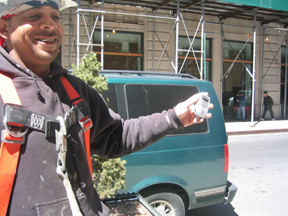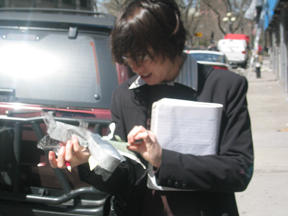
Overview
urban algorithms is a street level immersive game which interrupts, disturbs and includes random strangers and their cell phone conversations as part of gameplay.
Game Play
Two teams begin at the same street corner. Each team will approach a different person on their cell phone and ask where they are talking to. The team will then move in that direction one block. (So if the person is on the phone to China, the team moves one block east. If the person is on the phone to Harlem, the team moves one block north) At the next corner, the team finds another person on a cell phone and repeats the process.
There are multiple ways to move through the city. Chose one:
- One team/person moves begins in Times Square and moves following the rule set for one hour. After doing this, the person/team moves to another location in the city where there is no grid (ie the village) and moves following the rules set for one hour. If team/person chooses to do another area, look at documentation of other groups and choose area that has not been done before.
- Same as above, only target one type of person – ie women, or men, young people, old people- to question about location of person on other end of phone.
- Have 2 teams that begin in the same place. Follow the rule set until one team gets to a pre-determined location. This team wins.
- One team/person begins in Times Square and moves following the rule set for one hour. This person comes back to same location at different times of the same day and repeats the algorithm.
- Alternatively, the person can do the rule set at the same time every day for a week.
Rules
- Each team will move through the city for 1 hour, beginning at the same location
- Each team must move one block at a time
- The team must ask one person on the street corner where they are standing- you cannot cross the street to ask someone on another corner, nor can you ask more than one person
- The team must move in the geographical direction of where the person is talking to. (see overview for breakdown)
- Ask them to take a picture with their cell phone and send it to our blog.
- Yes (and does it immediately) gives team 2 credits
- Yes (and takes the email for later) gives team 1 credit
- Ask them to send a text message with a summary of their conversation
- Yes (and does it immediately) gives team 2 credits
- Yes (and takes the email for later) gives team 1 credit
Use of Credits
- A credit can be used to move one block in any direction when there is no one to ask, or too many no answers
- A credit can be used to cross the street to another, busier corner when there is no one on the corner

